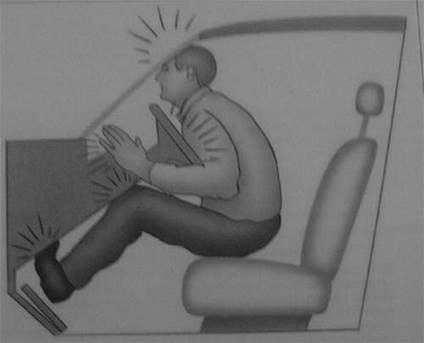Do you know that 40,000 people die each year in car accidents according to the figures? Car accidents top the causes of death for people under the age of 35. Safety belts are introduced to protect people in car accidents and they can prevent death in about half of these accidents. Most of time, we are obliged and are unwilling to wear seatbelts. But do you actually know what role do seatbelts play when a car crashes? I hope this article will convince you to use such safety facilities willingly out of safety considerations.
The Human Collision
Imagine running as fast as you can – into a wall. You’d expect to get pretty banged up. Do you think you could stop yourself if the wall suddenly loomed up when you were two feet away from it? This is exactly the situation you face when the front of your car hits something at only 15 miles an hour. The car stops in the first tenth of a second, but you keep on at the same rate you were going in the car until something stops you – the steering wheel, dashboard or windshield – if you’re not wearing your safety belt.. Bad enough at 15 miles an hour, but a 30 miles you hit “the wall” four times as hard as you would at 15. Or to put it another way, with the same impact you’d feel as if you fell three stories.
A properly worn safety belt keeps that second collision – the human collision – from happening.
Wear It Right
“Properly worn” means with both straps snugly fitted to transfer the impact of the collision to the parts of your body that can take it – your hipbones and shoulder bones. With just the shoulder strap on, you can still slide out from under it and be strangled, while the lap belt alone doesn’t keep your face from hitting the steering wheel.
What’s Your Reason For Not Wearing One?
“I’m only going to the shopping center.” Actually, this is the best time to wear a safety belt, since 80% of traffic fatalities occur within 25 miles of home and under 40 miles an hour.
“I won’t be in an accident: I’m a good driver.” Your good driving record will certaily help you avoid accidents. But even if you’re a good driver, a bad driver may still hit you.
“I’ll just brace myself.” Even if you had the split-second timing to do this, the force of the impact would shatter the arm or leg you used to brace yourself.
“I’m afraid the belt will trap me in the car.” Statistically, the best place to be during an accident is in your car. If you’re thrown out of the car, you’re 25 times more likely to die. And if you need to get out of the car in a hurry – as in the extremely tiny percent of accidents involving fire or submergence – you can get out a lot faster if you haven’t been knocked unconscious inside your car.
“They’re uncomfortable.” Actually, modern safety belts can be made so comfortable that you may wonder if they really work. Most of them give when you move – a device locks them in place only when the car stops suddenly. You can put a little bit of slack in most belts simply by pulling on the shoulder strap. Others come with comfort clips, which hold the belt in a slightly slackened position. If the belt won’t fit around you, you can get a belt extender at most car dealerships.
“I don’t need a belt – I’ve got an airbag.” Lucky you! An air bag increases the effectiveness of a safety belt by 40 percent. But air bags were never meant to be used in place of safety belts, since they don’t protect against side impacts at all.

The Important and Necessary Seatbelts
by
Tags:

Leave a Reply